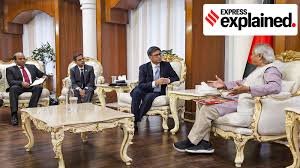28 March 2025 Indian Express Editorial
What to Read in Indian Express Editorial (Topic and Syllabus wise)
Editorial 1 : A Tax in Our Interest
Context: Equalisation levy
Genesis of the Equalisation Levy
- Introduction and Legal Framework
- Introduced in 2016 via the Finance Act and not the Income-tax Act.
- 6% levy on online advertising services.
- Objective: Address tax avoidance by digital corporations and bypass treaty overrides.
- Strategic Rationale
- Treaty Override Prevention: Taxpayers could not challenge the levy under international tax treaties.
- Targeting Low-Tax Practices: Aimed at multinational tech firms with historically low global tax rates.
International Tax Developments
- OECD's BEPS Initiative
- OECD’s Base Erosion and Profit Shifting (BEPS) program failed to deliver a unified solution for taxing digital economies.
- India’s Unilateral Move: Introduced the levy despite criticism of undermining international tax diplomacy.
- Global Responses
- Criticisms: Accusations of double taxation, increased consumer costs, and unilateralism.
- Domino Effect: Inspired other countries to adopt similar measures.
- Key Negotiation Challenges
- Profit Allocation Debate: The US preferred to draw a line in the sand with only residual returns, India firmly believed that an agreed formulary apportionment of profits was the way ahead.
- OECD’s Compromise: Lengthy negotiations influenced by US dominance.
Shift to the UN Framework
- UN Tax Convention (2024)
- 110 Countries supported an UN-led tax convention.
- Proposal: Simpler withholding tax on cross-border digital service payments.
- Significance: Highlighted alternatives to OECD’s consensus-driven model.
- Challenges to UN Model
- Withholding Tax Limitations: Similar consensus hurdles as OECD’s approach.
- Dilemma of Developing Countries: Growing scepticism about OECD’s fairness.
US-India Tensions and Retaliation
- US Trade Actions
- 2020 USTR Investigation: Declared India’s expanded levy (2% on digital services) discriminatory.
- Retaliatory Tariffs: Threats under Trump and Biden administrations.
- Impact on India’s Policy
- Withdrawal of 2% Levy: To avoid trade tensions.
- 2024 Context: Potential withdrawal of 6% levy amid renewed US pressure.
Critiques and Defence of the Levy
- Opposition Arguments
- Discriminatory Design: Allegedly targeted US tech firms.
- Consumer Burden: Costs passed to end-users.
- Defence and Revenue Impact
- Revenue Generation: ₹40 billion in 2022.
- Tax Avoidance Check: Levied in absence of global profit taxation mechanisms.
Withdrawal and Implications
- Timing and Motives
- Pre-emptive Move: Likely to de-escalate US trade tensions.
- Global Deal Vacuum: No OECD or UN agreement in place.
- Long-Term Lessons
- Domestic Measures as Tools: Demonstrated developing nations’ ability to assert tax sovereignty.
- Consensus Illusion: Highlighted limitations of relying on international cooperation.
Conclusion: The equalisation levy was a bold experiment in taxing digital economies, despite its eventual rollback. It reinforced the need for equitable global tax frameworks and exposed power imbalances in international tax diplomacy.
Editorial 2 : Re-Engaging Dhaka
Context: Muhammad Yunus’ China visit and India-Bangladesh relations.
India’s Diplomatic Success Under Sheikh Hasina
- Strengthened Cooperation
- Economic and security ties between India and Bangladesh deepened under Hasina’s leadership.
- Cross-border insurgency reduced due to Dhaka’s crackdown.
- Countered Chinese influence in South Asia, aligning with India’s strategic interests.
- Strategic Advantage
- Bangladesh served as a key partner in India’s Neighbourhood First policy.
- Enhanced connectivity projects and trade agreements bolstered regional stability.
Current Developments: Shifting Dynamics Post-Hasina
- Political Transition
- Sheikh Hasina’s ouster in August 2024 led to the formation of an Interim Government under Chief Advisor Muhammad Yunus.
- Domestic political uncertainty persists, with elections pending.
- India’s Muted Engagement
- PM Modi sent a congratulatory note to Yunus but has avoided direct engagement.
- Missed opportunities for meetings at the UN General Assembly last year and uncertainty around the BIMSTEC Summit in Thailand.
- Recent outreach via Modi’s letter on Bangladesh National Day (March 26) signals cautious diplomacy.
Challenges for India
- Bangladesh’s Growing Ties with China
- Military and Economic Collaboration
- Bangladesh joined China’s Belt and Road Initiative (BRI).
- Conducted joint military drills and pursued Chinese defence acquisitions.
- Recent Engagements
- Yunus visited China (March 26–29, 2024).
- High-level exchanges between Chinese and Bangladeshi officials, including a 21-member delegation to China.
- Military and Economic Collaboration
- Renewed Bangladesh-Pakistan Relations
- Four ISI officials visited Dhaka, followed by a Bangladeshi military delegation’s trip to Pakistan.
- This indicates Bangladesh’s intent to revive ties with Pakistan, partly to counterbalance India’s influence.
- Strategic Implications
- China and Pakistan aim to reduce India’s dominance in South Asia.
- Bangladesh seeks to diversify partnerships, reducing reliance on India.
Way Forward: Strategic Recommendations for India
- Engage Proactively with the Interim Government
- Dialogue with Yunus: Prioritize high-level meetings to sustain bilateral momentum.
- Recognize Transitional Nature: Avoid overinvesting in the Interim Government. Focus on long-term stability post-elections.
- Broaden Political Outreach
- Engage Opposition Parties: Initiate dialogue with the Bangladesh Nationalist Party (BNP) and National Citizen Party to hedge against political shifts.
- Avoid Election-Centric Approach: Prepare for all electoral outcomes rather than waiting for a preferred result.
- Reinforce Security and Collaboration
- Border Security: Address cross-border threats through intelligence-sharing.
- Counter-Terrorism and Trade: Expand cooperation on counter-terrorism and regional connectivity projects (e.g., BIMSTEC).
- Address Minority Concerns: Urge the Interim Government to ensure the safety of Hindu minorities to prevent communal tensions affecting bilateral relations.
Conclusion: Key Considerations for India
- Upcoming Elections: The Interim Government’s temporary mandate underscores the need for India to stay neutral and flexible.
- Domestic Uncertainty in Bangladesh: Political volatility necessitates a multi-stakeholder approach.
- Balancing Regional Rivals: Countering China and Pakistan’s influence requires a mix of diplomacy, economic incentives and security assurances.


